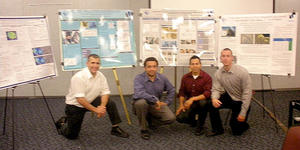From June to August, the 2009 PEER undergraduate interns were hard at work conducting their summer research projects. At the NEES Young Researcher Symposium in Buffalo, NY in late august, their efforts paid off when they were awarded three out of seven awards: two won best poster presentation for their session and one student won the overall best presentation award. View the 2009 intern's research papers and posters.
This year's intern program was unique compared to the programs of previous years, in that all four students conducted research in different disciplines related to one primary topic: Nonductile Concrete Buildings. Matt Zahr, a UC Berkeley student, worked on enhancing a web-based risk and hazard mapping tool that can identify the risk to nonductile concrete building inventories under the direction of Nico Luco at USGS in Golden, Colorado. Emmett Seymour, a Cal Poly San Luis Obispo student, helped the Concrete Coalition verify and validate their inventory of nonductile concrete buildings in the state of California under the direction of Marjorie Greene, Thalia Anagnos and Craig Comartin. Jack Moehle advised two interns doing work related to PEER's NEES Grand Challenge Project at the nees@berkeley laboratory. Cal Poly San Luis Obispo student Victor Sanchez, built and tested a nonductile concrete building moment frame joint while Bryce Lloyd from San Jose State University worked on computer analysis by accurately modeling the joint behavior in OpenSees.

The student projects were designed to be comprehensive projects that could be completed during the summer while having achievable goals and outcomes. According to Matt, "I really liked my project. I enjoyed coming into work everyday with an ultimate goal in mind. Previous internships that I had involved completing tiny, dead-end jobs. In this internship, Nico briefed me on some of the goals for the risk map web tool in the first couple weeks and the rest of the summer was spent working toward that goal. Once I reached those goals, I added additional options to the web tool that were outside the immediate USGS goals." Victor also appreciated how he was given a specific experimental test to complete from start to finish. "The fact that my project was a complete project that involved everything from ordering the material to the construction and testing of the specimen, gave me a great opportunity to experience a bit of how real research works."
During regular webex conference calls where the students presented their research progress to all four students and their advisors, the students learned more than their own research project. These calls allowed them to better appreciate the complex issues of the topic and see how research results can be enhanced by multi-disciplinary projects.
The final requirement of this summer's program is for the PEER interns to present their research project and experience to their fellow students at the meeting of a local student club at their home university. These presentations are intended to allow the summer interns to share their excitement from their research project and expose their fellow students to the possibility of research-based studies.
Special thanks are extended to NEES, Inc for funding this successful educational program.
posted SEPTEMBER 1, 2009
